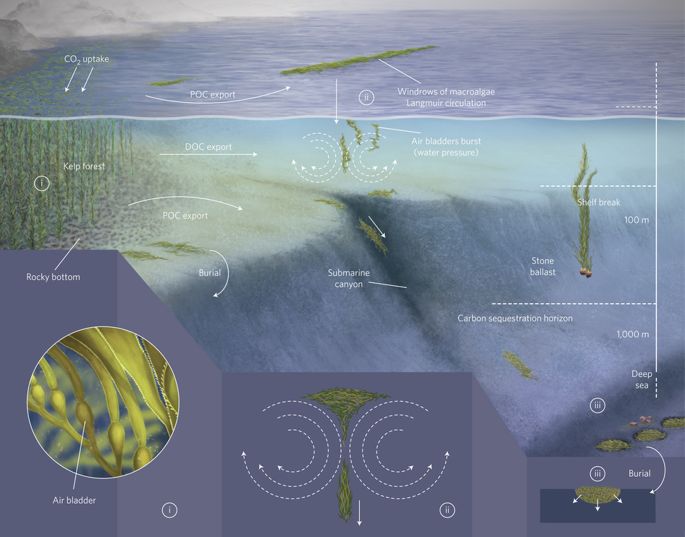Kelp Contribution to Carbon Sequestration in Marine Sediments
Project Summary
Even with Paris carbon emission-reduction commitments the world is facing a mean 3.5°C temperature rise. The promotion of kelp-derived blue carbon sequestration is emerging as an exciting opportunity to mitigate climate change. Kelp beds are the dominant primary producers in the coastal zone, with global production of 28.3 tonnes CO2eq ha-1yr–1. High-level estimates suggest approximately 11% of carbon fixed by kelp is sequestered near-permanently (100s-1000s of years) in deep (>1,000m) marine sediments. With 3 year's funding from the MBIE Endeavour Fund, we are testing this hypothesis with direct data measurement in the New Zealand context, where rich kelp beds and adjacent deep submarine canyons provide a unique ability to produce kelp biomass that can be exported to the deep sea.
This research is supporting New Zealand’s transition into a low-emission economy by providing data required to include kelp-sequestered carbon into the country’s carbon budget and potentially inclusion in carbon markets (voluntary and mandated). This will incentivise the protection of existing natural kelp beds and the development of new kelp aquaculture, not only for its nutritional, pharmaceutical, mussel co-culture, agricultural, energy and bioremediation opportunities, but critically, for biological carbon capture and storage.
Together with the National Institute for Atmosphere and Water (NIWA) we will quantify the accumulation of kelp-derived carbon in deep-sea environments (continental shelf, slope, and submarine canyons) in the vicinity of natural kelp beds. This will be achieved using a range techniques; stable isotope biomarkers as well as environmental DNA (eDNA) and the highly sensitive droplet digital PCR (ddPCR) method, combined with radiocarbon dating and data on sediment flows and accumulation rates. By determining carbon concentrations, age and biological source along the length of these cores, we will establish for the first time, a relationship between coastal kelp-biomass and the quantity and longevity of kelp-derived carbon sequestration in offshore benthic sediments.
The research will be conducted in the Kaikoura and Cook Strait canyon systems which, due to their steep geomorphologies and proximity to the coast, are known to funnel substantial amounts of material from coastal environments to the deep sea. The seabed and water column will be sampled in a grid encompassing each canyon as well as the adjacent shelf and continental slope to provide kelp-carbon concentration gradients in each area. We will estimate the biomass of large kelp species (including Laminariales and Fucales) present along the coastline adjacent and upstream from the canyons based on published data and further primary data collection if required.

The NIWA Regional Ocean Modelling System (ROMS) developed by Steve Chiswell, Mark Hadfield and Graham Rickard predicts dispersal for particles released around the NZ coastline (see below). This supports our assumption of kelp-detritus flows from the North East coast of the South Island towards the deep waters of the Hikurangi trench. We plan to use our research findings to calibrate ROMS such that we will be able to develop a geo-referenced kelp carbon sequestration calculator. Click on the graphic below to see the effect of particle dispersal over time from the NZ coastline. This model suggests that much of the kelp detritus produced along the east coast of NZ will disperse towards the deep waters of the Hikurangi and Kermadec trenches.